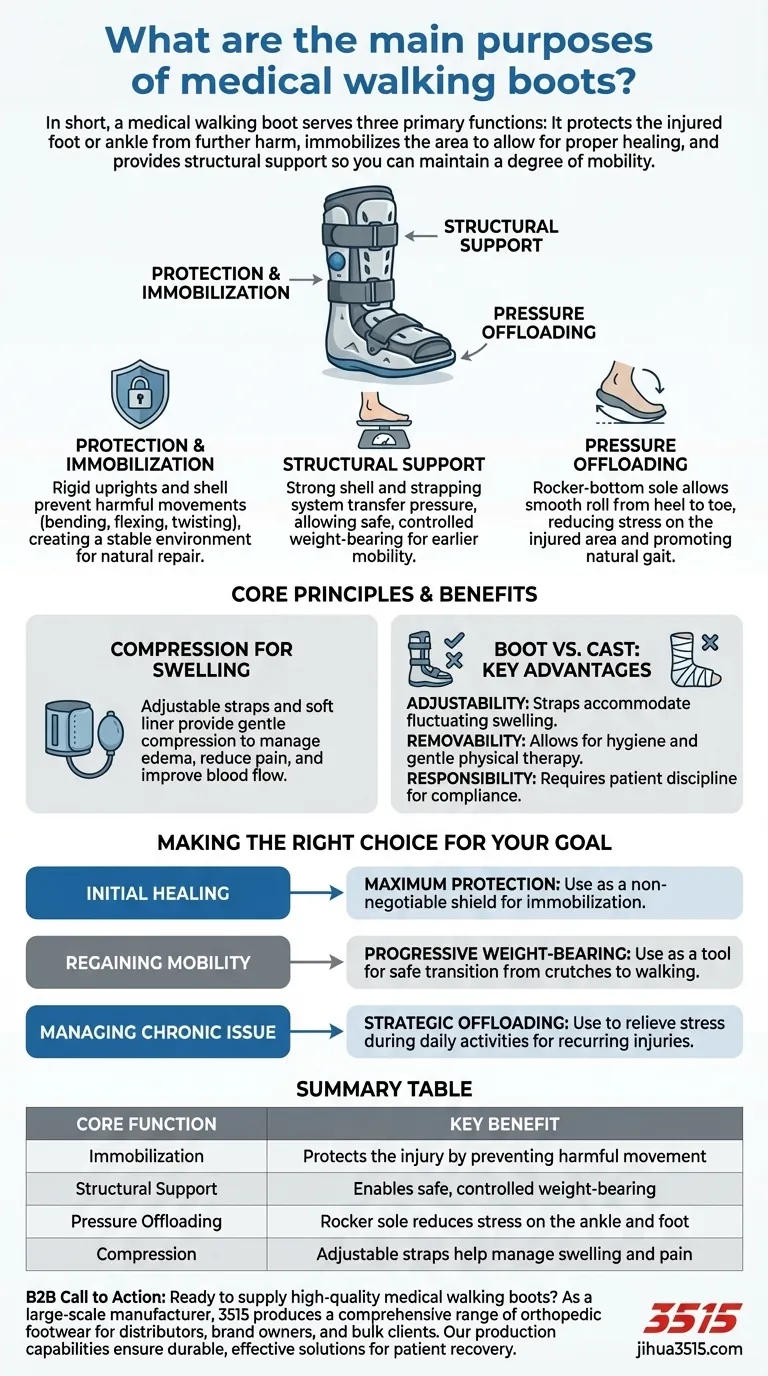In short, a medical walking boot serves three primary functions: It protects the injured foot or ankle from further harm, immobilizes the area to allow for proper healing, and provides structural support so you can maintain a degree of mobility.
The core purpose of a medical walking boot is to strike a critical balance. It provides the rigid protection of a traditional cast while allowing for the controlled movement, hygiene, and adjustments necessary for a faster and more functional recovery.

The Core Principles of a Walking Boot
A walking boot, often called a CAM (Controlled Ankle Motion) boot, is an orthopedic device engineered to solve several problems at once during the healing process.
Immobilization to Protect the Injury
The most critical function is to immobilize the ankle and foot. The rigid uprights on the sides and the supportive shell prevent motions like bending, flexing, or twisting that could disrupt healing bones, ligaments, or tendons.
This creates a stable environment for the body's natural repair processes to occur without being disturbed.
Support for Controlled Weight-Bearing
Unlike a traditional cast that often requires crutches for non-weight-bearing, a walking boot is designed to safely transfer pressure.
The strong shell and secure strapping system support the leg and ankle, allowing many patients to begin putting weight on their foot earlier in the recovery timeline, as advised by their doctor.
Offloading Pressure with a Rocker Sole
A key design feature is the rocker-bottom sole. This curved sole allows the foot to roll forward smoothly from heel to toe during a step.
This design significantly reduces the amount of bending required at the ankle and foot, offloading stress from the injured area and promoting a more natural walking gait.
Compression to Manage Swelling
The soft liner and adjustable straps provide gentle, consistent compression around the injury. This helps control edema (swelling), which in turn can reduce pain and improve blood flow essential for healing.
Understanding the Trade-offs: Boot vs. Cast
While serving a similar protective purpose, a walking boot has distinct advantages and responsibilities compared to a hard cast.
The Advantage of Adjustability
Swelling fluctuates significantly after an injury. A boot's straps can be easily loosened or tightened to accommodate these changes, maintaining a comfortable and secure fit that a static cast cannot offer.
The Benefit of Removability
Being able to remove the boot is its greatest advantage. This allows for cleaning the skin, which prevents irritation and infection.
Crucially, it also permits gentle, doctor-approved physical therapy exercises, which can prevent joint stiffness and muscle atrophy, leading to a much faster return to normal function.
The Responsibility of Compliance
The primary downside is the need for patient discipline. The boot is only effective when worn as prescribed. Removing it too often or for unapproved activities can delay healing or even cause re-injury.
Making the Right Choice for Your Goal
Understanding the boot's function helps align its use with your specific recovery phase.
- If your primary focus is initial healing: Use the boot as a non-negotiable shield to provide maximum protection and immobilization, especially when you are up and moving.
- If your primary focus is regaining mobility: Use the boot as a tool for progressive weight-bearing, allowing you to safely transition from crutches to walking with confidence.
- If your primary focus is managing a chronic issue: Use the boot to strategically offload stress from a recurring injury, such as a stress fracture or tendonitis, during daily activities.
Ultimately, a medical walking boot is an engineering solution designed to empower you to participate safely in your own recovery.
Summary Table:
| Core Function | Key Benefit |
|---|---|
| Immobilization | Protects the injury by preventing harmful movement |
| Structural Support | Enables safe, controlled weight-bearing |
| Pressure Offloading | Rocker sole reduces stress on the ankle and foot |
| Compression | Adjustable straps help manage swelling and pain |
Ready to supply high-quality medical walking boots? As a large-scale manufacturer, 3515 produces a comprehensive range of orthopedic footwear for distributors, brand owners, and bulk clients. Our production capabilities ensure durable, effective solutions for patient recovery. Contact us today to discuss your sourcing needs and elevate your product line.
Visual Guide

Related Products
- Safety Footwear Wholesale Manufacturer for Custom OEM/ODM Production
- Customizable Anti-Smash Safety Boots for Wholesale & Private Label Manufacturing
- Premium Grain Leather Safety Boots for Bulk Supply
- Custom Wholesale Leather Safety Boots Direct Factory Manufacturing
- Premium Wholesale Wheat Nubuck Safety Boot with Rapid Lacing System
People Also Ask
- What are OSHA approved shoes? Understanding the Correct Standards for Workplace Safety
- What are the differences between steel toe, composite toe, and alloy toe Wellington boots? Choose the Right Safety Toe for Your Job
- What are the cultural perspectives on wearing shoes in the house? A Guide to Home Etiquette & Hygiene
- Do snake bite boots work? Your Ultimate Guide to Effective Snake Bite Protection
- How long can you wear safety boots? The Lifespan is Determined by Wear, Not Time



















